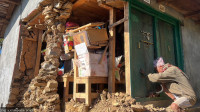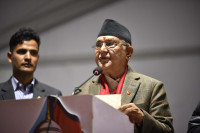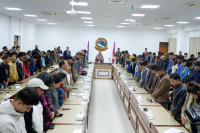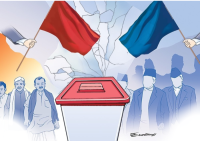Opinion
Long walk to recovery
Last year’s quakes seem to have exacerbated Nepal’s water crisis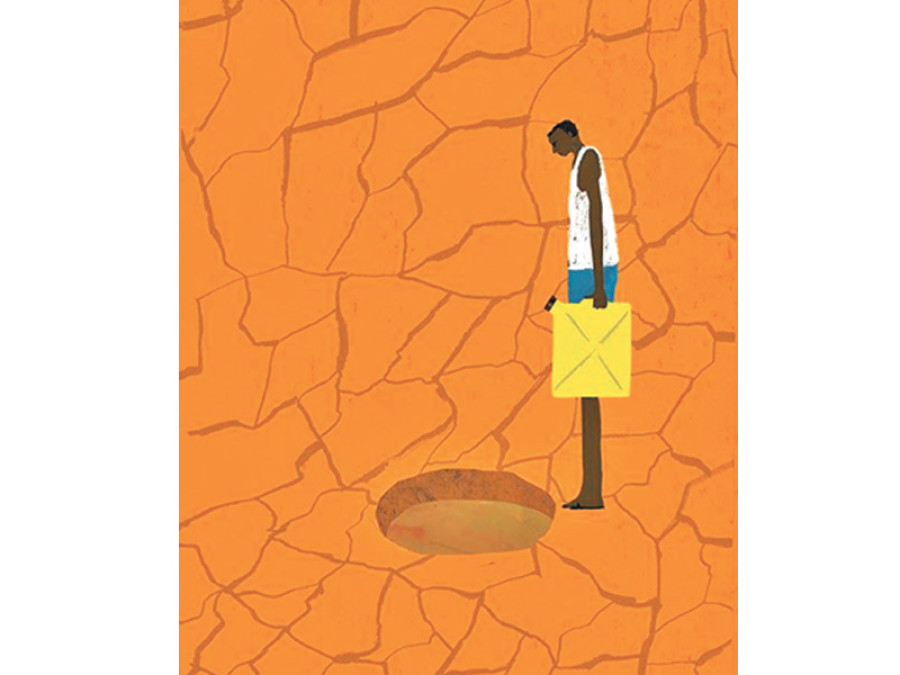
Heema Rai
I can hardly manage enough drinking water for the family. I’ve given up trying to manage water for my garlic plants”, says Farsaman Tamang of Susla, Solukhumbu as he shows us his sadly wilted garlic plot. Farsaman is the chairperson of Bhotetham Farmer’s Group in his village. He had been making decent income through garlic cultivation for the past two years. I had met him for the first time some two years ago when he was waiting for a visa to fly off to the Gulf. One of the reasons Farsaman abandoned his plans and stayed put was the hope instilled in him by his success in making money through garlic and other vegetable farming.
Farsaman’s village always had a water scarcity problem similar to what many Nepali villages face. “But in no previous year has it been as worse as this year,” say his neighbours in unison as I sit with them for a discussion about the water situation. Their reliable water source, which fed two taps even during the driest summer spell, has significantly depleted this time around. The villagers believe the water level sunk after the May 12 earthquake.
As I walk to another village Hurlam, half way at River Rog, I meet an elderly Mani Tamang washing her clothes. It will take her about an hour of an uphill climb from the river to reach her home in Hurlam. I see that she has come prepared—with a backpack to carry her clothes and snacks for the day. Mani used to have a decent spring relatively closer to home, but this year it has dried up completely, leaving her with no choice but to regularly make a journey down to the river spending about half a day.
After last year’s earthquakes, many communities from Khotang and Solukhumbu, with whom I work closely, have reported a change in their water sources. In a few cases, the water level has increased but, alarmingly, in a majority of cases, the levels have dipped. Some water sources have completely dried up.
The change in water sources caused by the earthquakes has been felt more prominently this summer. Even formidable sources of water, which never ran out, have been exhausted. People are making do with very little water. This plight is shared by people from other districts too, as is evident from regular reports of drought and water shortage from various parts of the country. In my hometown of Khotang, locals point at trickling natural taps and barren rice terraces, and recall how there used to be enough water to flood those terraces for summer rice planting.
Climate change
Nepal is one of the most vulnerable countries to climate change. Himalayan glaciers—the perennial source of water for most streams and ground water in Nepal, have been receding at an alarming rate of 38 square kilometres per year. According to the Ministry of Population and Environment, the annual precipitation reduction rate is projected to be at the range of 10 to 20 percent across the country. Climate change had already been pushing Nepal towards a serious water crisis. Last year’s quakes seem to have exacerbated this situation.
According to US Geological Survey, hydrogeologic responses to earthquakes, like water wells becoming dry, new ones forming, and degradation of water quality both near and far from the epicentres, have been known for decades. The recovery to pre-earthquake water levels is sometimes immediate, while at other times it might take months. Sometimes, there never is a recovery. From the look of things around our hills, it seems the recovery is never going
to come or is going to come too late for crucial sources that feed entire villages.
This water crisis is not looking like the water crises of other times. The earthquakes must have drastically changed the water table of many settlements, either significantly reducing the water availability of the sources or rendering them completely dry. These dried up or reduced sources do not look like they will be reinvigorating themselves come monsoon, as happens normally once the dry summer spell is over. Locating and making use of another water source is going to be an expensive and arduous affair. This needs both financial and technical input, which many times people of the rural areas lack.
4,000 landslides
Another equally alarming longer-term consequence is landslides. Besides damage to physical infrastructure, landslides are another frequently reported consequence of an earthquake. There are plenty of examples in seismic history throughout the world where landslides induced by an earthquake have caused significant devastation. In Peru in 1970, a 7.8 magnitude earthquake produced a landslide 130km away from the epicentre which killed more than 18,000 people.
However, like the water crisis, landslides have been neglected during the discussions of earthquake recovery, in which the focus has mostly been on ‘rebuilding’ and ‘reconstruction’. I have seen numerous landslides along the hills, especially around areas on either side of rivers. A study team that included the International Centre for Integrated Mountain Development (ICIMOD) mapped over 4,000 landslides as a direct result of the Gorkha earthquake. These landslides are not only a risk for the future, but are also causing socio-economic perils in the present. In Boksuwar, a day’s walk from Susla, parents have stopped sending their small children to school when the trail to their school was swept away by landslides last monsoon.
It is indeed fortunate that except in a few cases such as the Taplejung landslide, there have been a relatively small number of landslide-related tragedies till now. But we must note that many Nepali hill villages are surrounded by multiple landslides, which is akin to sitting on top of booby traps. I cannot begin to imagine the havoc that could be caused if the monsoon rain triggers further landslides.
Is it only when actual lives are lost and actual irreparable damage occurs that this issue will get our attention? Is there nothing like a “prevention is better than cure” concept in our national psyche?
The impact of earthquakes on such matters like water availability and landslides that could potentially lead to complete erasure of villages is not getting as much attention as it should. Death and damage to homes and other physical infrastructure of course will get more attention in the immediate aftermath of a crisis. It has now been a year since the quakes; by this time, we should have been already researching about and tackling the issues beyond immediate visible destruction. But we are in such a state that people are still forced to live in temporary shelters and might have to weather a monsoon or two before getting a sturdy roof above their head. If the apathy continues, we will undoubtedly find even the hardiest of optimists like Farsaman off to demonstrate “Nepali resilience” growing vegetables in some desert stretch of the Middle East.
Rai is with the dZi Foundation, which works with communities in Solukhumbu and Khotang




 14.12°C Kathmandu
14.12°C Kathmandu

